Organic artefacts: lost or not? – Treasures of the Bronze Age cemetery of Nagycenk 3.
In our previous posts, we presented remarkable artefacts from the Nagycenk cemetery, dating between 2100 and 1750 BC. However, objects made of organic material, e.g. wood, bast fibre or textiles are usually not preserved at all or are highly fragmented due to the soil conditions in the Carpathian Basin.
The larger empty areas within the graves excavated in Nagycenk suggests that besides ceramic bowls, jars and pots, some tombs may have contained wooden vessels or wicker baskets with food offerings, that could no longer be traced during the excavation (Gömöri et al. 2018). Bronze or copper-rich burials are generally larger in size, often deeper than others – as shown in Figure 1. This implies that community members have devoted more work to construct graves of the elit, furthermore, it also draws attention to the possible presence of organic grave goods.
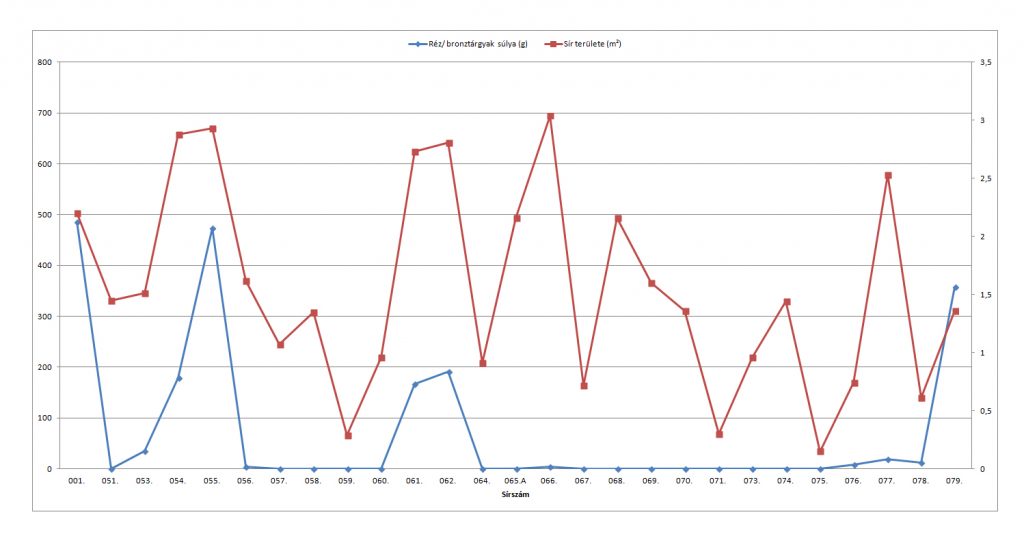
Relationship between the size of the tombs (red) and the weight of the copper / bronze artefacts (blue) (Gömöri et al. 2018, Fig. 31)
Nearly 4000-year-old of textile and leather remnants
The circumstances of the excavation of the Nagycenk cemetery did not allow observation of textile residues. However, plant fibres, made of flax and hemp, preserved by the corrosion of neck rings were identified in the roughly contemporaneous burial ground of Zsennye (Nagy 2013). Flax linen textile were preserved also by metal corrosion at the Franzhausen cemetery of the Unterwölbling culture, from the same period (Grömer 2010, 166–167, Abb. 84, Abb. 166).
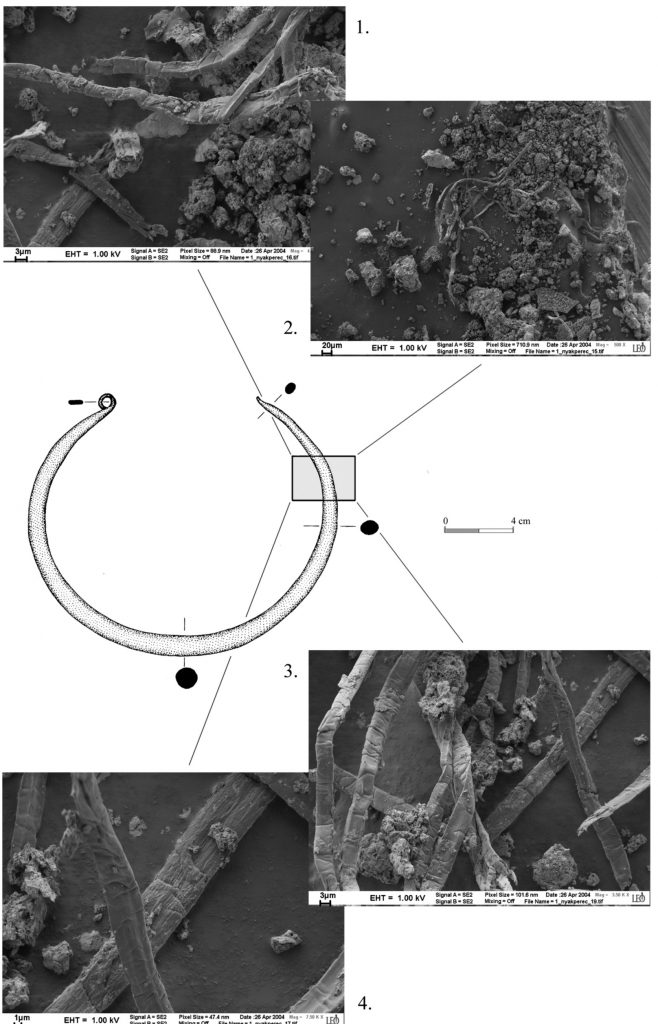
Traces of textile fibers on a bronze neckring from Zsennye (Nagy 2013, Taf. 41)
In a cemetery of similar age, discovered in the vicinity of Prague, the corrosion of bronze artefacts preserved wool fibers and human hair (Ernée 2015, 237245). In some cases, microscopic examinations could also be used to study the imprints of the wearer’s skin (Peška et al. 2006).

Human skin imprint on the inside of a ring from a grave excavated at Hulín – “U Isidorka” (2004–2005) (Peška et al. 2006, Obr. 40)
Chief and/or a master carpenter at Nagycenk?
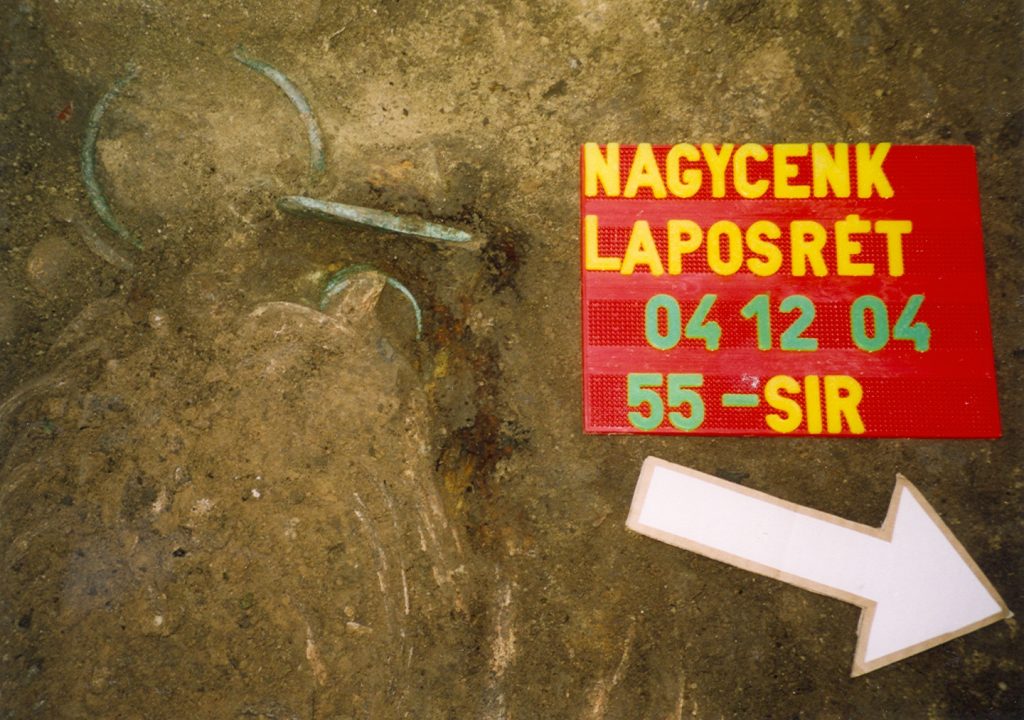
Details of Nagycenk Grave 55 with the traces of the adze shaft (Gömöri et al. 2018, Fig. 8)
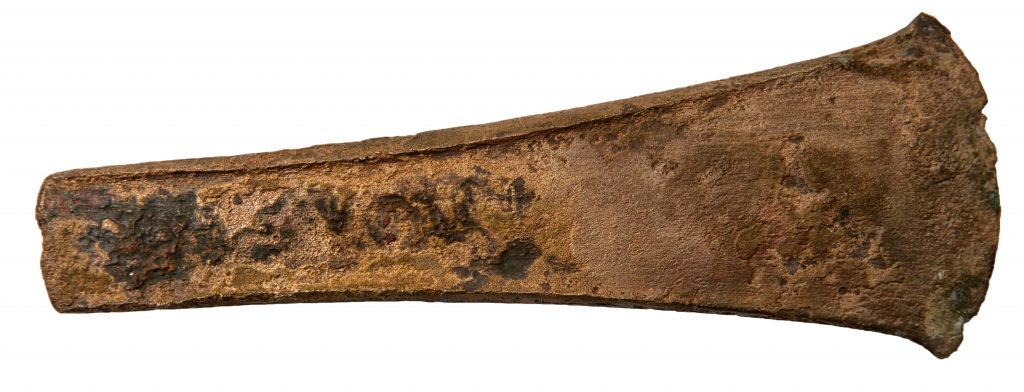
The adze after conservation (Photo: Hámori Péter)
This provides important data on several ways of using these bronze tools. The axe of Ötzi – the Iceman preserved by the glaciers in the Ötz Valley, who had lived around 3300 BC, i. e. 1500 years before those buried at Nagycenk – was shafted parallel to the edge of the bronze head, thus may have been used as a hatchet (Egg–Spindler 2009).

The copper axe of Ötzi with a yew shaft, glued with birch bark tar and bound with a leather strap
(South Tyrol Museum of Archaeology)
Ötzi’s axe had a 60 cm long shaft, while the Nagycenk adze shaft was preserved only 25-30 cm long (based on the photograph of the grave). The following, hatchet- or adze-like tools were made after similar, Western-European Bronze Age finds. They can be used for cutting or hollowing a tree trunk, thus provide a good example of the possible use of the Nagycenk artefact as well. The experimental archaeological reconstruction of the sewn ship of North Ferriby, England (contemporaneous with the Nagycenk cemetery) was made with the help of these tools (Van der Noort et al. 2014).
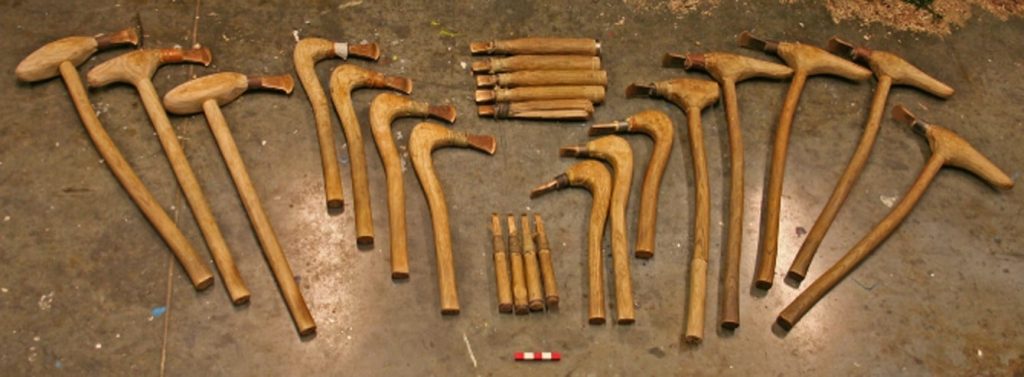
Tools used to build the reconstruction of the Bronze Age ship found at North Ferriby (left: axes/hatchets; right: gutter adzes) (after Van der Noort et al. 2014)

Reconstruction of the North Ferriby Bronze Age Ship (after Van der Noort et al. 2014) and a depiction of its Bronze Age use (after the illustration of The Telegraph)
The tool placed next to the middle-aged man in Grave 55 of Nagycenk may also indicate that the man was a person who made or owned a similar ship.
Viktória Kiss – Eszter Melis
References
M. Egg –K. Spindler: Kleidung und Ausrüstung der Gletschermumie aus den Ötztaler Alpen. Monographien RGZM 77. Mainz 2009.
M. Ernée: Prag-Miškovice. Archäologische und naturwissenschaftliche Untersuchungen zu Grabbau, Bestattungssitten und Inventaren einer frühbronzezeitlichen Nekropole. Römisch-Germanische Forschungen 72. Darmstadt, 2015.
Gömöri J., Melis E., Kiss V.: A cemetery of the Gáta–Wieselburg Culture at Nagycenk (Western Hungary). Acta Archaeologica Academiae Scientiarum Hungaricae 69 (2018) 5–82.
Grömer, K.: Prähistorische Textilkunst in Mitteleuropa – Geschichte des Handwerks und der Kleidung vor den Römern. Veröffentlichungen der Prähistorischen Abteilung des Naturhistorischen Museums 4, Wien 2010.
Nagy, M.: Der südlichste Fundort der Gáta-Wieselburg-Kultur in Zsennye-Kavicsbánya/Schottergrube, Komitat Vas, Westungarn. Savaria 36 (2013) 75–173.
Peška, J. – M. Králik – A. Selucká: Rezidua a otisky organických látek v korozních produktech mědi a jejích slitin. Pilotní studie. Industrie starší doby bronzové (Organic Matter Residuals and Imprints in Products of Copper and Copper Alloy Corrosion A Preliminary Study Early Bronze Age Industry). PamArch 97(2006) 5–46.
Van der Noort, R., Cumby, B., Blue, L., Harding, A., Hurcombe, L., Hansen, T.E., Wetherelt, A., Wittamore, J., Wyke, A.: Morgawr: an experimental Bronze Age-type sewn-plank craft based on the Ferriby boats. International Journal of Nautical Archaeology 43 (2012) 292–313. https://onlinelibrary.wiley.com/doi/epdf/10.1111/1095-9270.12058








